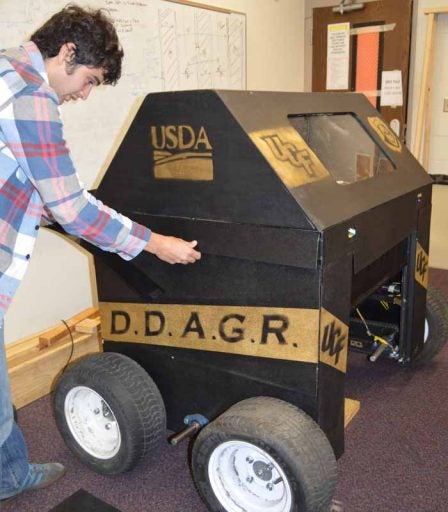If you’ve spotted a black-and-gold robot winding its way up and down rows of strawberry plants at Pappy’s Patch in Oviedo recently, you weren’t dreaming. The robot is part of a research project that could help identify citrus and strawberry disease earlier than ever before.
Citrus and strawberries are a big part of the economy in Florida, and with a variety of diseases taking their toll, ways of identifying the diseases earlier are critical.
Mechanical engineering associate professor Yunjun Xu and a group of his students have been creating the robot since 2013 when Xu and University of Florida agricultural engineer and associate professor Reza Ehsani landed a U.S. Department of Agriculture grant worth more than $1.2 million. The goal is to develop an automated system that would use robots and specialized sensors in the air and on the ground to detect and report disease in citrus groves and strawberry fields.
The prototype robot is the size of a small generator and carries eight cameras, spectral sensors, a GPS, four batteries, and complex software instructions to direct it to glide up one row and make a U-turn when needed before heading back down another row. It can adapt to roam in narrow or wide fields and can go for several miles before needing a charge. There is also a protected space onboard the robot to house the sensors. Xu’s graduate and many senior design course students worked as a team to create the working prototype.
“We are fine-tuning it now,” Xu said.
Currently, people have to go into the fields and search for symptoms of different diseases. This is time consuming, expensive and prone to error. Early detection of a disease is hard because people can only detect a disease when the symptoms are visible, and in some cases waiting for symptoms to appear could be too late for the best management, Ehsani said.
Ehsani and his students are progressing on the special sensors that will be able to detect and report disease information quickly. He works from his lab at the Citrus Research and Education Center in Lake Alfred and travels to UCF when needed.
Much of the first two years at UCF was spent on what Xu calls “less than glamorous work.” His team built the vehicle, developed software architecture, and tested out the prototypes to ensure they would work in field conditions where the soil type and terrain can be challenging. The team has another three years to complete the project.
Xu expects to continue testing and adapting the prototype robot before more field testing is completed this summer. For now, Xu and his students continue to work on the robot, taking it apart to get into the engineering building and rebuilding it when it’s ready to hit the strawberry patch again.
“We’re getting there, one step at a time,” Xu said.
